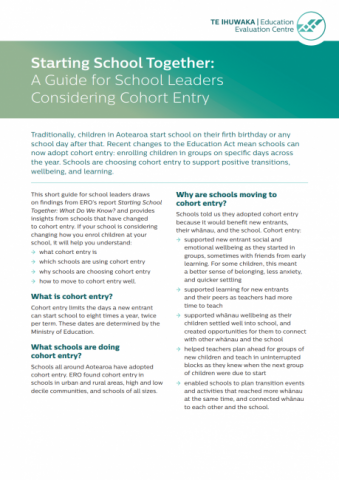Summary
This short guide for school leaders draws on findings from ERO’s report Starting School Together: What Do We Know? and provides insights from schools that have changed to cohort entry.
Whole article:
A Guide for School Leaders Considering Cohort EntryThis short guide for school leaders draws on findings from ERO’s report Starting School Together: What Do We Know? and provides insights from schools that have changed to cohort entry. If your school is considering changing how you enrol children at your school, it will help you understand:
- what cohort entry is
- which schools are using cohort entry
- why schools are choosing cohort entry
- how to move to cohort entry well.
What is cohort entry?
Cohort entry limits the days a new entrant can start school to eight times a year, twice per term. These dates are determined by the Ministry of Education.
What schools are doing cohort entry?
Schools all around Aotearoa have adopted cohort entry. ERO found cohort entry in schools in urban and rural areas, high and low decile communities, and schools of all sizes.
Why are schools moving to cohort entry?
Schools told us they adopted cohort entry because it would benefit new entrants, their whānau, and the school. Cohort entry:
- supported new entrant social and emotional wellbeing as they started in groups, sometimes with friends from early learning. For some children, this meant a better sense of belonging, less anxiety, and quicker settling
- supported learning for new entrants and their peers as teachers had more time to teach
- supported whānau wellbeing as their children settled well into school, and created opportunities for them to connect with other whānau and the school
- helped teachers plan ahead for groups of new children and teach in uninterrupted blocks as they knew when the next group of children were due to start
- enabled schools to plan transition events and activities that reached more whānau at the same time, and connected whānau to each other and the school.
Considering cohort entry? How to do it well
The Education and Training Act 2020 requires schools considering moving to cohort entry to consult with their communities. Consultation must include school staff, current and prospective parents, and local ECE services.
Consultation is a chance to ensure cohort entry is right for your community. ERO asked schools about their consultation experiences. They shared the following advice.
Be clear on what you want to achieve
Principals shared that it was important to be clear with their communities on their rationale for changing their school enrolment process as it helped with making an informed decision and generating buy-in. They recommended:
- considering the pros and cons for children, whānau, teachers and ECEs
- identifying how cohort entry aligns with your commitment to improve learning outcomes for your learners
- identifying how cohort entry aligns with your school’s values, vision, and mission.
See cohort entry in action
Principals we spoke to recommended you visit schools where cohort entry is in place to learn about the implications of cohort entry for your school community—both inside and outside the school gate. When visiting, you could find out about:
- what other schools wanted to achieve
- how cohort entry impacted transitions
- the implications for staff management, community engagement, and teaching and learning.
As new entrant teachers are most affected by a change of entry, you could ask them about:
- the impact of cohort entry on their classrooms
- what works best to support teaching and learning
- what support and resourcing they need to transition new entrants well.
Work with your local ECEs
Ensuring ECEs are wrapped into the consultation and communication processes supports quality relationships with ECEs. It helps services adjust, as cohort entry can impact the flow of children through their service, and can support effective and positive transitions. Principals we talked to suggested:
- surfacing challenges and issues with ECEs early, and helping them problem-solve
- communicating with ECEs regularly, as they are often the first point of contact for whānau
- coordinating transition activities.
Whilst cohort entry may not work for all schools, schools that have adopted it have experienced clear benefits. Your school may wish to consider adopting cohort entry.
For cohort entry information for schools: www.education.govt.nz/school/managing-and-supporting-students/starting-school/cohort-entry-in-schools/
To locate a cohort entry school: https://www.educationcounts.govt.nz/find-school
